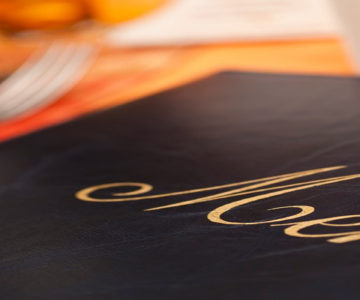How to create a Restaurant grade menu €¦
Nov 07, 2016Student Leadership Development Institute
By Kevin Ellul
Creating a menu takes a lot of time and thought as you need to be creative, articulate, and generally simplistic. Saying this, your customers should be able to read your menu with no problem; articulating vocabulary to the simplest form for better understanding. Throughout this article, I will discuss the components of creating a menu, from cuisines and themes to tastes, textures, and the initial development of a dish and menu.
Cuisine
Creating a menu entails that you have a determined cuisine or a diversity of cuisines that work well together. There are many cuisines in the world, with few being first choices. These include: French, Italian, Chinese, and Spanish. Many chefs modernize traditional dishes aimed towards a cuisine; today they tend to set a theme and create their dishes using research, seasonality, and creativity.
Theme
Many restaurant owners theme their restaurants to attract customers. Look at Olive Garden; A very popular Italian influenced restaurant with a set house menu. Theming restaurants and menus are important because it €™s what attracts the customers to dine. Themes also include seasonality- specifically using ingredients available within certain seasons. Themes can be anywhere from countries, certain dates, or focused on one specific ingredient (ex. Mushrooms). Courses are also considered a €œtheme €- primarily pertaining to tasting menus (a multiple coursed menu). Many restaurant €™s offer tasting menus, which are constantly changing, or a house menu, which is consistently the same every day.
Tastes and Textures
Think of tastes and textures as the initial food and ingredients. For example, a carrot could exemplify a texture; using it either raw for a crunchy texture or cooked for a soft texture. To a chef, tastes and textures are a big part of menus. Incorporating as much flavor and texture in a dish creates an excellent dining experience €¦ for the consumer and the chef. One interesting factor is color; color reflects taste as you eat with your eyes first. If you create a dish that has a neon yellow sauce, you would think of lemon; however, it might not be €”which creates an interesting reaction to the mind and palate of the consumer.
The human palate has a total of five senses of taste, which are: Sweet, Salty, Bitter, Sour, and Umami. Each taste has a different effect on flavors- and some even enhance flavors, such as sweet, salty, and sour.
€œSweet €
Sweetness will cut through acidity and salt and take the edge off of bitterness. Sweetness- specifically meaning €œsugar €, adds a certain depth to a dish, which draws out certain flavor enhancers.
€œSalty €
Salty, one of the most important tastes. It increases depth and enhances flavors within a dish. Just as sugar, salt cuts the unwanted bitterness out of ingredients and draws out moisture within food; therefore, creating more of a moist texture. Salt isn’t the only €œsalt € derivative; soy sauce, cheese, or olives can be used to induce a salty punch.
€œSour €
Sour, primarily acid, is the second most important taste to use while creating a dish. Almost every dish is better with some form of acid- or sourness. Vinegar, lemon juice, soured dairy, or even wine can be used to create a presence of acid within a dish. However, if too much sourness is present, Sugar and salt will help balance it out. The best part about all of these tastes is BALANCE. Balancing tastes and flavors is what a chef loves to do.
€œUmami €
This taste is one that is always there, but is never realized. Umami is described as a savory taste. Mushrooms, steak, cheese, and even tomatoes are of umami decent. The word, Umami, derives from Japanese language, meaning; Pleasant Savory Taste. The taste is really associated with glutamates found in foods containing proteins. A form of umami can be added to foods by using glutamic acid created into a €œpowder € known as MSG (Monosodium Glutamate).
€œBitter €
Believe it or not, all bitter foods aren €™t bad, especially if they are properly balanced. Bitterness derives mainly from leafy greens; however, it can also be found in herbs, spices, dark chocolate, olive oil, and even coffee. The benefits of bitter food are: healthy antioxidants, detoxification properties, and essential vitamins and minerals.
Textures
Textures are very distinctive to a dish €™s creation. Texture has a variety of meanings; assume every ingredient as a texture- whether it’s fish, nuts, or ice cream. Cooking techniques pertain to textures as well; sautéing, a high temperature cooking technique, condones a Maillard reaction. It €™s a reaction occurring from mainly any food by the means of browning and caramelization of amino acids and natural sugars occurring within. This reaction isn’t much about just color; however, presumably the flavors associating with it, a roasted-nutty hue.
While developing a dish, one must think about flavor, color, and texture €”as I’ve mentioned. Proper textures, even so, multiple textures, are important to include in EVERY dish. Some components to remember while constructing your masterpiece are: The Main Component (use as a texture), Sauce (sauce, liquid-like texture), Garnish (whichever texture resembles garnish €”a powder can be used as a garnish), Earth (can be similar to garnish, earth resembles herbs, nuts, fruit, vegetables, starch, or edible greens and flowers), and lastly Crunch/Crispy (a crispy or crunchy ingredient, including a crumble). Other textures, which are mostly seen today are silky, spongy, airy, flaky, and gelatinous. These are the best textures for more modern and gastronomic dishes today.
Description is Key; Price is Everything!
Descriptive words and adjectives are what sells the dish! Make sure you are descriptive within your menu and recipes. This will attract the customers to dishes of their likings. No one likes to read, €œfish fillet with skin €, but a €œcrispy skinned fillet of fish €, will sell and look better on a menu. Just as description is key, the price of the dish, finalizes the sale. While creating your menu, efficiently cost your dishes and recipes by the amount of ingredients residing on the plate. Too high of prices might steer your customers away, too little will lose you money.
Developing Recipes and Dishes
The development of recipes is what forms the dishes residing on menus. It €™s what composes each dish to the tee, and informs you of everything from a splash of milk, to a dash of salt. A recipe consists of an ingredients section and a procedure section. Therefore, creating a dish isn €™t easy, everything within the article previously mentioned should be included, as well as, plating style, and the plate itself. Weight, Grams, Ounces, Tablespoons, and Cups are amongst the vocabulary for measurements of recipe development. Vocabulary is very important in a recipe, it should be simple and easy to understand. Chefs generally have their own ways of honing their skills, either creating a dish by blending ingredients or drawing up sketches of their ideas, then executing them.
Here is an example of how to create a dish, then execute your idea, or recipe.
My idea is to create an Haute Cuisine inspired dish; this means it is of French Influence and ultimately of several courses. This dish has modern elegance and fine dining stature. The season is Fall, thus a Fall tasting menu is in order. I will be highlighting seasonal ingredients within my dish, focusing on farm fresh/locally grown and foraged organic ingredients.
The menu is themed €œJourneying into Fall € (captivating fall flavors, colors, and ingredients as the fall season comes closer to an end). I will be representing the second course on a four course menu I €™ve created. I have looked into local seasonal ingredients; I have chosen Trout, Lemons (available year round), Cranberries, Parsnips, and Tarragon. Now that I have my ingredients, the possibilities are endless in what to create with them. I have decided to name my dish: Lemoned Trout.
My question now is, what components do I add to this dish? The Trout will be descaled, filleted, and portioned into 3 oz. skin-on fillets. Next, I will make a compound butter, which is a flavored and aromatic butter and this will consist of Lemon Juice, Zest, Tarragon and Salt. The trout will be sautéed and basted in the lemon-tarragon butter which will coat the fish with an abundance of flavor and reflect crisp, crunchy skin. Now, that I have my main protein thought out, I now need to create the rest of the dish with elements, textures, and flavors. Thinking about components, I’ve decided to Blister Cranberries, making it similar to a cranberry relish, creating a thinned puree of Parsnips (Parsnip Broth), and developing a deep green- flavorful oil of tarragon. After the fish is perfected, the oil is finished, the puree is complete, and the cranberries have blistered; I’ve planned and drawn out my dish in entirety. For my plating, I have picked a shallow bowl with a larger rim. I will place the hot puree/broth onto the bottom of the bowl, spreading it into a thin circle, coating the bottom. Next, I will add about one to two tablespoons of the blistered cranberries directly in the middle of the puree, this will be room temperature. After that, I will add the hot, butter drenched, crispy skinned trout on top of the berries, the skin side will face up- towards the customer. Lastly, the dish will be finished with a slight drizzle of tarragon oil. For Garnish, I wish to add red mustard green frills, and sea salt.
I have created my dish, as well as, an entire menu, you can view it here:
FIRST COURSE
Pickled Fall Salad
Pickled Sharon Fruit, Roasted Beets, Frisse, Candied Pistachios, Coriander Yogurt
SECOND COURSE
Lemoned Trout
Lemon Butter, Blistered Cranberries, Parsnip Broth,
Tarragon Oil
THIRD COURSE
Sunflower Chicken
Sunflower Seeds, Sunchokes, Sweet Potato Gnocchi, Potato Gnocchi,
Sage Brown Butter, Sunflower Oil
FOURTH COURSE
Deconstructed Apple Pie
Spiced Apple, Walnut Powder, Caramel Sauce, Broken Sugar, Pate Brisse,
Whipped Cream, Apple Chip, Cinnamon Ice Cream
This menu has been executed by myself and a team of students within the Great Chefs Restaurant here at Walnut Hill College. The event was a wine dinner challenge consisting of these four courses and eight wines to taste.
Walnut Hill College presents a Wine Dinner Challenge every month, take a look to see what’s in store for the future and Click Here!
You can also view the Great Chefs Menu here as well!
-Student Leader, Kevin Ellul
Culinary Arts, Class of July 2017


